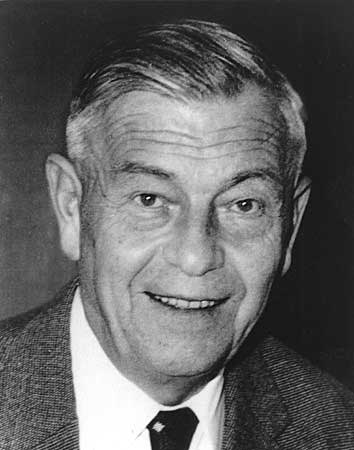Thomas W. Busch was born in Kimberly, Wisconsin, in 1923. Following his graduation from Kimberly High School, he attended college for two years before joining the United States Air Force in 1942. He achieved the rank of Captain and served as a meteorologist. In 1946, he returned to college under the G.I. Bill; in addition, he applied to the Rotary Club for a loan.
Fred Heinritz, Sr., who was then president and general manager of The Appleton Coated Paper Company, was on the loan committee and told Mr. Busch to stop in to see him when he finished college, because there might be a job for him. There was, and Mr. Busch started work the day after he graduated from Lawrence University.
The research function in the company in 1948 dealt with those technical activities associated with the paper business, such as measuring properties of papers, measuring flow of coatings, and testing of finished products. The main thrust in the laboratory at that time was developing products for which the marketing department saw a need, pursuing quality control, and developing methods to coat papers.
Fundamental research and the discovery of new information began in 1954 when Mr. Busch worked with chemists from NCR Corporation to modify the basic carbonless paper formulations, allowing them to be commercially coated. Through his laboratory and manufacturing skills, along with his dedication to his profession, Appleton Papers was established as the world leader in the manufacture of carbonless and thermal papers.
During his career, Mr. Busch pursued a systematic approach in identifying the issues and concerns that had to be dealt with, working out a plan to solve those problems. Known for his superior insight in technology, people, and business, Mr. Busch helped establish teams for basic research and applied research and development engineering. Team members consisted of cross functional employees from research and development, manufacturing, and finance.
Mr. Busch conceived the idea for on-line paper machine production for carbonless paper. He assembled and directed a problem-solving team and made on-line manufacturing a possibility. This success led to the converting of old mills to carbonless manufacturing, turning marginal mills into profitable companies. Other ideas of his that were managed and implemented included flexo and bill blade coating on the paper machine; high velocity drying; high solids coating; tandem coating; and in-line calender.
Mr. Busch recognized the value of education to generate information that the industry could implement. He used The Institute of Paper Chemistry for testing, information, and space. He also recognized the value of the Technical Association of the Pulp and Paper Industry (TAPPI), and he strongly encouraged his coworkers and associates to participate.
Over the years, Mr. Busch made many significant contributions to TAPPI through his writing. In 1968, he was a contributing author to the book Industrial and Specialty Paper. TAPPI articles included Coated Weight Controls, 1965; Paper Coating Additives, 1966; The Shape of the Future, 1978; TAPPI Monograph Paper Coating Additives, 1978; Future Technical Needs and Trends, 1979; Productivity, 1980; Coated Paper Production, 1980; and Innovating for Profit Venice, 1980.
Mr. Busch has received patents for the method for the manufacture of double coated sheets with pressure rupturable materials, 1972; method and means for coating paper with pressure rupturable fluids containing capsules, 1971; and high-speed means and methods for emulsion coating thin paper, 1967. Through his contributions in coating rheology, base paper, coating interface concepts, and pre-coated papers, a new industry was born with worldwide sales of over six billion dollars annually. In the industry, his technological contributions have been applied in both on-machine and off-machine coating. His contributions have made possible the elimination of several steps in the manufacturing process.
TAPPI has referred to carbonless paper as “one of the outstanding paper-related innovations of the past half century, matched perhaps only by the invention of the xerographic imaging process.” The testimony to carbonless paper’s success is the public’s demand for it.
Mr. Busch has held memberships in the American Chemical Society; American Management Association; Graphic Arts Research Council; Graphic Arts Technical Foundation; and TAPPI. He also served as a director of TAPPI, and in 1978 he became a Fellow. In 1981, he received TAPPI’s Coating and Graphic Arts Division Award; and in 1986, he received the Community Service Award from the Paper Industry Management Association (PIMA).
In his 37 years with Appleton Papers Inc., Mr. Busch advanced through the ranks from chemist to chairman and chief executive officer, with much of his career focusing on research and development. He retired in 1985 at age 62 to care for his wife, who was ill.
Mr. Busch and his late wife, Genevieve, raised seven children. Besides his professional and family responsibilities, he has been an active participant in his community and church, having served as a director of Appleton Rotary Club; Appleton YMCA; Fox Valley Symphony; Junior Achievement; United Way; Villa Hope; Franciscan Health Care, Inc.; Xavier Foundation; and St. Elizabeth Hospital. Mr. Busch maintained his home in Appleton and continued his volunteer activities with St. Joseph’s Food Program until his death in 1999.






